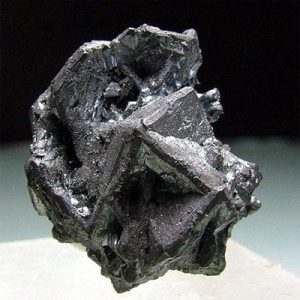Chalcocite
Chalcocite is an important ore of copper and a secondary mineral in or near the oxidized zone of copper sulfide deposits. It has been mined for centuries and is one of the most profitable copper ores because of its high copper content (nearly 80% by weight) and the ease at which copper can be separated from sulfur. However, it is not the primary ore of copper due to its scarcity. The richest Chalcocite deposits have probably been mined out but it is still being mined. Fine crystals of Chalcocite are quite uncommon and are very sought after. The now depleted mines at Cornwall, England and Bristol, Connecticut produced the most famous clusters of wonderfully formed Chalcocite crystals.
Since Chalcocite is a secondary mineral that forms from the alteration of other minerals, it has been known to form pseudomorphs of many different minerals. A pseudomorph is a mineral that has replaced another mineral atom by atom, but it leaves the original mineral’s crystal shape intact. Chalcocite has been known to form pseudomorphs of the minerals Bornite, Covellite, Chalcopyrite, Pyrite, Enargite, Galena and Sphalerite. Pseudo means false and morph means shape or morphs thus pseudomorph means false shape since the mineral is Chalcocite but the shape is that of another crystal, Covellite for example.
Distribution: An important and widely distributed ore mineral of copper. Only a few localities producing exceptional crystals or pure masses can be listed. From the Turinsk copper mine, Bogoslovsk, Ural Mountains, Russia. In England, fine crystals from Cornwall at St. Just, St. Ives, Camborne, and Redruth. In the USA, exceptional crystals from Bristol, Hartford County, Connecticut; in Arizona, at Bisbee, Cochise County; from the Magma mine, Superior, Pinal County; in the United Verde Extension mine, Yavapai County; from Butte, Silver Bow County, Montana; crystals at the Flambeau mine, southwest of Ladysmith, Rusk County, Wisconsin; from Kennicott, Copper River district, Alaska. Large crystals from Nababiep West mine, Cape Province, and Messina, Transvaal, South Africa. At M’Passa, Niari Province, Congo Republic. In the Mashamba West mine, Kolwezi, Katanga Province, Congo (Shaba Province, Zaire). Fine crystals from Telfer, Western Australia.
| Category: | Sulfide minerals |
| Chemical Formula: | Cu2S |
| Copper Sulfate | |
| Molecular Weight: | 159.16 gm |
| Composition: | Copper | 79.85 % | Cu | ||
| Sulfur | 20.15 % | S | |||
| 100.00 % |
| Crystallography: | Monoclinic – Prismatic |
| Crystal Habit: | Crystals are short prismatic [001], thick to tabular {001}, to 12 cm across, and prismatic [100], to 25 cm long; {001} is striated || [100]. Massive, compact, fine powdery. |
| Twinning: | Common on {110} yielding pseudohexagonal stellate forms; also on {032}, {112}. Seen as lamellar twinning in polished section. |
| Cleavage: | Indistinct on {110} |
| Fracture: | Conchoidal |
| Tenacity: | Brittle, somewhat sectile. |
| Moh’s Hardness: | 2.5 – 3.0; VHN = 84–87 (100 g load) |
| Density: | 5.50 – 5.80 (g/cm3) |
| Luminescence: | None |
| Radioactivity: | Not Radioactive |
| Color: | Blue Black, Gray, Black, Black Gray, or steel Gray |
| Transparency: | Opaque |
| Luster: | Metallic |
| Refractive Index: | R1–R2: (400) 37.0–36.8, (420) 37.8–37.4, (440) 37.7–37.6, (460) 37.0–37.2, (480) 36.2–36.2, (500) 35.6–35.4, (520) 34.7–34.4, (540) 33.7–33.5, (560) 32.5–32.5, (580) 32.1–31.8, (600) 31.3–31.2, (620) 30.8–30.7, (640) 30.0–30.0, (660) 29.5–30.0, (680) 29.2–29.7, (700) 29.0–29.6 |
| Birefringence: | None; Opaque |
| Dispersion: | None |
| Pleochroism: | None |
| Anisotrophism: | Weak |


